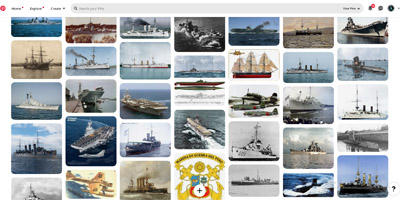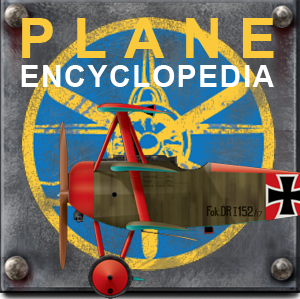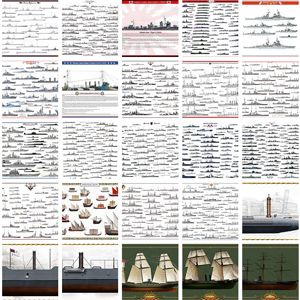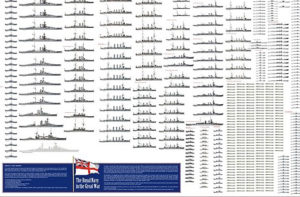 France: Magenta, Solferino 1859-63, Broadside Ironclads (1963-82)
France: Magenta, Solferino 1859-63, Broadside Ironclads (1963-82)Marine Nationale's Ironclads
Gloire class | Couronne Bd. Ironclad | Magenta class Bd. Ironclads | Arrogante class Flt. Batteries | Provence class | Embuscade class | Palestro class Flt. Batteries | Taureau | Belliqueuse Bd. | Ocean class | Alma classContinuing into French 1860s capital ships, after Couronne, the first French all-Iron answer to the Warriors, let’s see rather unique ships, bearing Italian sounding names (of recent Imperial Victories): The Magenta class. These French Navy (Marine Nationale) early 1860s vessels designed by famous naval architect Dupuy de Lôme were the only two-deckers ever built, as well as the first ironclads to feature a naval ram as integral to the hull. They were classed as “ironclad ships of the line” and remained world’s unique ships for this. They would remain under commission until 1875 for Magenta (written off after an accidental explosion) and Solferino in 1882.
The Magenta is one of a series of ships designed by Dupuy de Lôme between 1859 and 1872, described as the “largest wooden-hulled vessels ever built in French shipyards” with a series of 23 capital ships.
Design of the class
The Magenta class originated from the same naval architect Henri Dupuy de Lôme which created the Napoléon in 1850, first steamship of the line, and Gloire, first sea going ironclad in 1859. The latter class was criticized for their Frigate’s lower battery was unworkable in the North Atlantic heavy weather, as their gun ports were impaired by seawater splashes and sometimes high waves.
Dupuy de Lôme addressed these concerns by a radical idea: Giving them an upper spar deck with guns workable in all weathers. They still kept a normal battery deck underneath. This rather unique solution had them presented as “ironclad ships of the line” and they remained unique in that guise in the French Navy. They were ordered years before the battle of Lissa (1859) and yet Dupuy de Lôme theorized their machinery meant they also could use a ram in combat. Gloire and sister ships indeed had a “snout” ram, more an afterthought, a short projection forward of the hull. Having an integral ram, i.e. integral part of the hull structure and shaping it, was new and revolutionary at the time. Couronne as completed as also had a ram, but it was short, and also an added piece.
Having a long projection, the “spur ram”, starting from the forecastle deck to well under the waterline, creating a long almost triangular projection into a point at the waterline, well reinforced by added beams and structural elements to “buffer” the shock of the ramming. These were all new and untested ideas, making these ships double oddities. The ramming idea was also evoked by several historians at in 1859 as an antique tactic now available with steam power again, and Napoleon III took a great interest in naval archaeology, so much so he ordered in 1860 a Roman Galley for testings.

The Roman Trireme reconstituted by Gaston Braun, model of the Marine Museum in Paris in 1861. It was tried on the Seine in Paris and in the Bay of Seine, but the trials were not satisfactory to say the least, at it seems the architect did not manage to lay out the internal rowers positions the right way. The British-Greek Olympias succeeded in this around 1985, however. No trireme was ever attempted again.
Again, they were watched with a suspicious interest on the other side of the pond. However, De Lôme could not standardize the design among the two shipyard concerned, when the ships were ordered respectively to Arsenal de Brest and Arsenal de Lorient, both on the Atlantic coast. Thus, as completed, they diverged in many ways. They were also, like the Gloire, wooden built.
Hull and general design
Magenta indeed measured 88.6 meters (290 ft 8 in) overall, but Solferino was shorter at 85.51 m (280 ft 7 in) long. Both had however the same beam of 17.34 meters (56 ft 11 in) and same draft of 8.44 meters (27 ft 8 in). Magenta displaced however substantially more than her sister at 6,965 metric tons (6,855 long tons) and Solferino displaced 6,796 t (6,689 long tons). The spur-shaped ram added almost ten meters (32 ft) to their overall length compared to the forecastle’s tip.
They also had a slight tumble home to further increase stability, as the Gloire were also criticized for rolling heavily. The way the armour was also installed contributed to better balance despite their overall height.
These ironclads had a crew of 674 officers and enlisted men. The battery was located on two levels at the center of the ship, with the battery ports continued by squared windows, which from afar would seem like added portholes. The final result looked like a classic “frigate” in disguise. Apart to the ram, probably difficult to see at a distance, she could have closed on an unsuspected other 1st rank frigate or ship of the line, confident of victory, wait for a harmless broadside, and then unleash one of its own. A deadly trap. However, in the long run that idea was doomed simply by the size and weight of the new generation of rifled breech loaders, which needed reinforced decks. Two decks was now excluded for stability reason, albeit new central battery ironclads would have for many a two-level battery. The difference was its concentration on the point of balance of the ship.
Powerplant
The Magenta class, given their ram and newly found ability, needed to be fast. They were given the best French industry could provide as a steam powerplant at the time. Both were given a single, but massive two-cylinder horizontal-return connecting-rod (HRCR) from Mazeline, a compound steam engine driving a single axial 2-bladed propeller shaft. Steam came from by eight* oval boilers which diverged by Yard but offered greater pressure. This engine was rated at 1,000 nominal horsepower, 3,450 metric horsepower (2,540 kW) for a speed above 13 knots (24 km/h; 15 mph).
*Sources differ. Gille and Silverstone: eight. Campbell: nine. (Conways).
Sea trials however were disappointing: Solferino only achieved 12.88 knots (23.85 km/h; 14.82 mph) from 4,012 metric horsepower (2,951 kW). This proved not they were bad steamers, but that their hull shape was too bulky and not optimized enough to overcome resistance. The peculiar shape of the ram, just below the waterline, also created extra turbulences. However, unlike the Gloire class, they proved more stable, with a metacentric height of just about 1.6m.
The Magenta class called for a mass of coal to feed their massive steam engine, between 625 and 800t, for a total of 1,840 nautical miles (3,410 km; 2,120 mi) at 10 knots (19 km/h; 12 mph).
Of course alongside this powerplant they were given a three-masted barquentine rig with a sail area of 1,711 square meters (18,420 sq ft) for long crossings. If tested at sea, we don’t have their speed under sail alone. It was probably not helped by the hull shape either. The rigging was found insufficient and later amplified as barques with 1,960 square meters (21,100 sq ft) in 1864–1865. They were overall considered to be good seaboats, but not very manoeuvrable.
Magenta became the most recognisable French ironclads and very popular with the public, depicted in numerous press illustrations, engravings, paintings and also photographs. Her figurehead, an imperial eagle, was removed following the fall of the Second Empire.
Protection
Abover their thick wooden hull, they received a full-length waterline belt made of wrought-iron plates, 120 mm (4.7 in) thick. Above it was a thinner, second battery belt 109 mm (4.3 in) thick still, over both battery levels. This was a lot, so both ends were left completely unprotected. Meaning outside the central section, most (1/3) of the ship was vulnerable, but that was a price to pay to well protect its battery. There was also, like for Gloire, a conning tower close to the rear deck, protected by 100 mm (4 inches). Her steel plates were cast in Saint-Chamond and fixed on wood, some acting as flexible backing. This protection weighted a total of 812 tonnes. The bronze spur also designed at Saint-Chamond Navy steelworks, weighted 15.8 tonnes alone, and then was “the largest single cast steel piece forged in France in the 19th century”.
Armament
Originally, both ships were completed with a double volley and two large deck guns. Originally they had 48 canon de 16cm Modèle 1858-60, but it was changed in 1864, 1866, and 1868, twice. Her lower gun deck was 1.96 m high to compare with Couronne’s (1.79 m) and Gloire’s (1.81 m), found to low. Despite this, she had an upper battery gun for two covered gun decks.
The lower battery was divided between sixteen 194mm/16 50pdr SBML, eight per side, completed by five (out thirty-four) 165mm/17 M1858 MLR, for 13 lower ports and 12 upper battery ports with the remaining as shown on plans with the lighter 165mm/17 M1858 MLR. The largest ones were two 223mm/12 shell SBML (Paixhans guns) located for the forward one under folding shutters at the prow as chase guns in complement to the ram and the other aft on a turntable.
-194-millimeter (7.6 in) Modèle 1858–60: Smoothbore muzzle-loading guns
-164.7-millimeter (6.5 in) Modèle 1858–60: Rifled muzzle-loading (RML) guns
-225-millimeter (8.9 in) RML howitzers: Explosive shells deck Howitzers.
All 194 mm guns, ten 164.7 mm guns were mounted on the lower gun deck. The remaining 164.7 mm guns on the upper battery deck, and the 225 mm howitzers were positioned on the upper gun deck, the latter on pivot mounts as chase guns fore and aft.
With a rapidly evolving gunnery tech, they were rearmed, and 1864-65 all lower gun deck were removed. In 1864 both lost all 34 165mm/17 guns replaced by 165mm/19 M1864 MLR. 1865, Magenta was rearmed again, loosing 24 of the remaining 165mm/19 for four 240mm/18 M1864 MLR and eight 194mm/19 M1864 MLR.
This was still a combo of four 240-millimeter (9.4 in) RMLs, eight 194 mm smoothbore, but the latter had tow placed fore and aft as chase guns on the upper gun deck.
Then in 1868 Magenta saw the removal of four 194mm/19 and all sixteen 194mm/16 and her ten 165mm/19 guns. Instead, she had only six 240mm/18 M1864-66 MLR and her hull was sheathed and reached 18.3 m in beam ().
In 1869, Solférino saw the removal of two upper deck 223mm/12, and all former 194 and 165mm batteries, but she gained ten 240mm/18 M1864-66 MLR (six on her sister) as well as four 194mm/19 M1864-66 MLR relocated on deck as chase guns, and like her sister her hull was sheathed. The 19cm weighted 11 tons.
240 mm Modèle 1864–66 guns: These weighted 20 tons and fired shells of more than 140 kg.

⚙ Magenta specifications |
|
| Displacement | 6,428 t (6,326 long tons) |
| Dimensions | 80.85 x 16.7 x 7.8 m (265 ft 3 in x 54 ft 9 in x 25 ft 7 in) |
| Depth of hold | 9.7 m (31 ft 10 in) |
| Propulsion | 1 shaft HRCR-steam engine, 8 oval boilers: 2,597 PS (1,910 kW) |
| Sail plan | Barquentine rigged |
| Speed | 12.5 knots (23.2 km/h; 14.4 mph) |
| Range | 2,410 nautical miles (4,460 km; 2,770 mi) at 10 knots (19 km/h; 12 mph) |
| Armament | 30 × 164.7 mm (6.5 in) rifled breech-loading guns |
| Protection | Belt 120 mm (4.7 in), CT 100 mm (3.9 in), deck 12.7 mm (0.5 in) |
| Crew | 570 |
Career of Magenta class
 Magenta (1861)
Magenta (1861)
Construction started in Brest on 22 June 1859. She was launched on 22 June 1861, armed on 2 January 1862 or 1863 depending on sources. In her first trials, damage to the propeller blades forced the Admiralty to replace them with steel blades. She took part in many Atlantic exercises with Solferino, Couronne, Invincible and Normandie from Cherbourg to the Canarias islands.
In 1864, the Magenta she saluted in Cherbourg the USS Kearsarge after its duel on 19 June against CSS Alabama out at sea. Magenta suffered minor damage in July 1865 and January 1866, due to hurricanes in Cherbourg. She escorted and evacuated French troops after the failed Mexican expedition in 1867. She left Cherbourg in 1868 for Toulon via Algiers as flagship on February 1, 1870, relieving her sister in that role.
Furthermore, she was in Tunis, on September 4, 1870 when the Franco-German War of 1870 broke out, and by February 1871, the Magenta participated in the repressions in Nice (troubles of February 8-10, local commune) and in May to quell a riot in Kabylie, North Africa. In reserve in July 1871 she was rearmed and commanded from April 15, 1875 by Charles-Eugène Galiber. She was off the coast of Syria-Lebanon by June-July 1875, picked up sailors of the sloop Forfait, shipwrecked. On 21 July, she became flagship for a six ironclads naval exercise, commanding five smaller Alma-class central battery ironclads in the Tyrrhenian Sea and Corsica when it happened. The sloop missed her manoeuvre and was rammed by Jeanne d’Arc, sinking in 14 min.
In September 1875 she was placed under control for an archaeological mission via Algiers to La Goulette in Egypt. Admiral Pierre-Gustave Roze on September 27 ensured the transfer of 46 crates of archaeological remains from the Archaeological mission Pricot de Sainte-Marie. She was in Toulon by October 30.
On 31 October, an accidental nighttime galley fire started aboard Magenta while in port at Toulon, and spread out of control. Still the crew managed to flood her forward gunpowder magazine but the fire prevented them to reach the aft magazine and the captain ordered to abandoned ship, and warned the surroundings; She blew up shortly afterward, 2 hours 55 minutes after the fire broke out. Thus tore down her hull, and she sank in 15 meters (49 feet) of water. She still carried at the time, back from Egypt, Carthaginian antiques, notably 2080 Carthaginian tombstones and a marble statue of Vibia Sabina. Divers were sent to study a refloating, but this was judged impossible. But most of her artefacts were retrieved over time. The wreck was located in April 1994 and fragments of stela recovered since, as well as the statue, with fragments now on display at the Louvre.
Note: The French wikipedia article goes into great depth after the accident.
 Solferino (1861)
Solferino (1861)

Solferino was Laid down 24 June 1859, launched on 24 June 1861 and commissioned on 25 August 1862.
Note: Missing Logs (for now). She was discarded in 1883.

Ocean, an ironclad inspired by the general hull design of the Magenta but first with barbette guns (pinterest, Maritime Museum).
Read More/Src
Books
Steam, Steel and Shellfire, The Steam Warship 1815-1905″, Conway’S history of the ship, Chartwell Books Inc.
Roger Chesneau and Eugene M. Kolesnik, ed., Conway’s All The Worlds Fighting Ships, 1860-1905, (Conway Maritime Press, London, 1979).
Links
https://www.navypedia.org/ships/france/fr_bb_magenta.htm
https://www.maritima-et-mechanika.org/maritime/paris/frenchironclads.html
https://en.wikipedia.org/wiki/Magenta-class_ironclad
https://fr.wikipedia.org/wiki/Magenta_(1861)
https://www.worldnavalships.com/battleships2.htm
https://modelshipworld.com/topic/29911-magenta-1861-by-grandpaphil-172-card-french-ironclad-broadside-battleship-built-as-designed/
Model Kits
None. The galleon/ship of the line had more success.
















 Latest Facebook Entry -
Latest Facebook Entry -  X(Tweeter) Naval Encyclopedia's deck archive
X(Tweeter) Naval Encyclopedia's deck archive Instagram (@navalencyc)
Instagram (@navalencyc)





 French Navy
French Navy Royal Navy
Royal Navy Russian Navy
Russian Navy Armada Espanola
Armada Espanola Austrian Navy
Austrian Navy K.u.K. Kriegsmarine
K.u.K. Kriegsmarine Dansk Marine
Dansk Marine Nautiko Hellenon
Nautiko Hellenon Koninklije Marine 1870
Koninklije Marine 1870 Marinha do Brasil
Marinha do Brasil Osmanlı Donanması
Osmanlı Donanması Marina Do Peru
Marina Do Peru Marinha do Portugal
Marinha do Portugal Regia Marina 1870
Regia Marina 1870 Nihhon Kaigun 1870
Nihhon Kaigun 1870 Preußische Marine 1870
Preußische Marine 1870 Russkiy Flot 1870
Russkiy Flot 1870 Svenska marinen
Svenska marinen Søværnet
Søværnet Union Navy
Union Navy Confederate Navy
Confederate Navy Armada de Argentina
Armada de Argentina Imperial Chinese Navy
Imperial Chinese Navy Marinha do Portugal
Marinha do Portugal Mexico
Mexico Kaiserliche Marine
Kaiserliche Marine 1898 US Navy
1898 US Navy Sovietskiy Flot
Sovietskiy Flot Royal Canadian Navy
Royal Canadian Navy Royal Australian Navy
Royal Australian Navy RNZN Fleet
RNZN Fleet Chinese Navy 1937
Chinese Navy 1937 Kriegsmarine
Kriegsmarine Chilean Navy
Chilean Navy Danish Navy
Danish Navy Finnish Navy
Finnish Navy Hellenic Navy
Hellenic Navy Polish Navy
Polish Navy Romanian Navy
Romanian Navy Turkish Navy
Turkish Navy Royal Yugoslav Navy
Royal Yugoslav Navy Royal Thai Navy
Royal Thai Navy Minor Navies
Minor Navies Albania
Albania Austria
Austria Belgium
Belgium Columbia
Columbia Costa Rica
Costa Rica Cuba
Cuba Czechoslovakia
Czechoslovakia Dominican Republic
Dominican Republic Haiti
Haiti Hungary
Hungary Honduras
Honduras Estonia
Estonia Iceland
Iceland Eire
Eire Equador
Equador Iran
Iran Iraq
Iraq Latvia
Latvia Liberia
Liberia Lithuania
Lithuania Mandchukuo
Mandchukuo Morocco
Morocco Nicaragua
Nicaragua Persia
Persia San Salvador
San Salvador Sarawak
Sarawak Uruguay
Uruguay Venezuela
Venezuela Zanzibar
Zanzibar Warsaw Pact Navies
Warsaw Pact Navies Bulgaria
Bulgaria Hungary
Hungary

 Bundesmarine
Bundesmarine Dutch Navy
Dutch Navy Hellenic Navy
Hellenic Navy Marina Militare
Marina Militare Yugoslav Navy
Yugoslav Navy Chinese Navy
Chinese Navy Indian Navy
Indian Navy Indonesian Navy
Indonesian Navy JMSDF
JMSDF North Korean Navy
North Korean Navy Pakistani Navy
Pakistani Navy Philippines Navy
Philippines Navy ROKN
ROKN Rep. of Singapore Navy
Rep. of Singapore Navy Taiwanese Navy
Taiwanese Navy IDF Navy
IDF Navy Saudi Navy
Saudi Navy Royal New Zealand Navy
Royal New Zealand Navy Egyptian Navy
Egyptian Navy South African Navy
South African Navy






























 Ukrainian Navy
Ukrainian Navy dbodesign
dbodesign